Introduction
Before we discuss how to Setup Crontab on Debian, let's first understand-What is a Crontab?
Cron is a time-based job scheduler on Unix-like systems, including Debian 12. It allows you to schedule and automate recurring tasks, such as running scripts or commands at specific intervals. Crontab is the command used to manage cron jobs on Debian 12.
This tutorial will provide instructions on setting up Crontab on Debian 12. We will also address a few FAQs on how to setup Crontab on Debian 12.
Advantages of Setting Up Crontab on Debian 12
- Automation of repetitive tasks: Crontab allows you to automate repetitive tasks, such as backups, log cleaning, or scheduled maintenance, reducing the need for manual intervention.
- Increased productivity: By automating tasks with crontab, you can focus on other important aspects of your work, knowing that routine tasks will be executed automatically and reliably.
- Flexibility in scheduling: Crontab provides flexible scheduling options, including specific times, intervals, days of the week, or specific days of the month, allowing you to tailor the execution of tasks to your specific needs.
- Error notification: Crontab includes the ability to send email notifications upon task completion or in case of errors, keeping you informed about the job's status without the need for manual checks.
- Centralized management: Crontab allows you to manage all your scheduled tasks in one place, providing a centralized location for reviewing, modifying, or disabling jobs as necessary.
Prerequisites:
To perform the steps that are demonstrated in this guide, you need the following components:
- A properly-configured Debian system. Learn more about installing Debian.
- If you’re currently running an older release, check out how to upgrade to Debian 12.
Crontab on Debian
In UNIX/Linux, cron is a command-line utility that can run the scheduled jobs at a specified time, date, or interval. The cron daemon starts at boot and handles the execution of the scheduled jobs. It’s a simple scheduling tool that most UNIX/Linux systems come with preinstalled (including Debian).
There are a couple of cron-related concepts that you should know about:
- crontab: It’s an abbreviation of the term “cron table”. It’s a system file that is structured like a table. Within the file, all the scheduled jobs are described (with specific time or interval).
- crond: It’s the cron daemon that runs in the background. The daemon starts at system startup and runs the various tasks that are described in the crontab.
- cron jobs: In the context of cron, each of the scheduled tasks are referred to as “jobs”.
Note that cron uses /bin/sh as the default shell.
Crontab File Locations
There are multiple crontab files available throughout the system:
/etc/crontab: The main system crontab/var/spool/cron/: It’s a directory that contains all the user-specific crontab/etc/cron.d/: It’s a directory that contains all the system crontab
Cron Permissions
Any cron job runs under a specific user. Thus, each job inherits the user permission of the owner.
For example, a normal user test isn't permitted to run the jobs that require a root permission. However, the root user can issue the jobs that can perform anything on the system. For example, updating the packages periodically.
Configuring Crontab
In this section, we will learn about working with crontab.
Viewing the Crontab
While we can directly manipulate the crontab files from the location that is specified before, it’s strongly recommended to use the “crontab” command to ensure stability and compatibility. To check the content of the crontab, run the following command:
crontab -l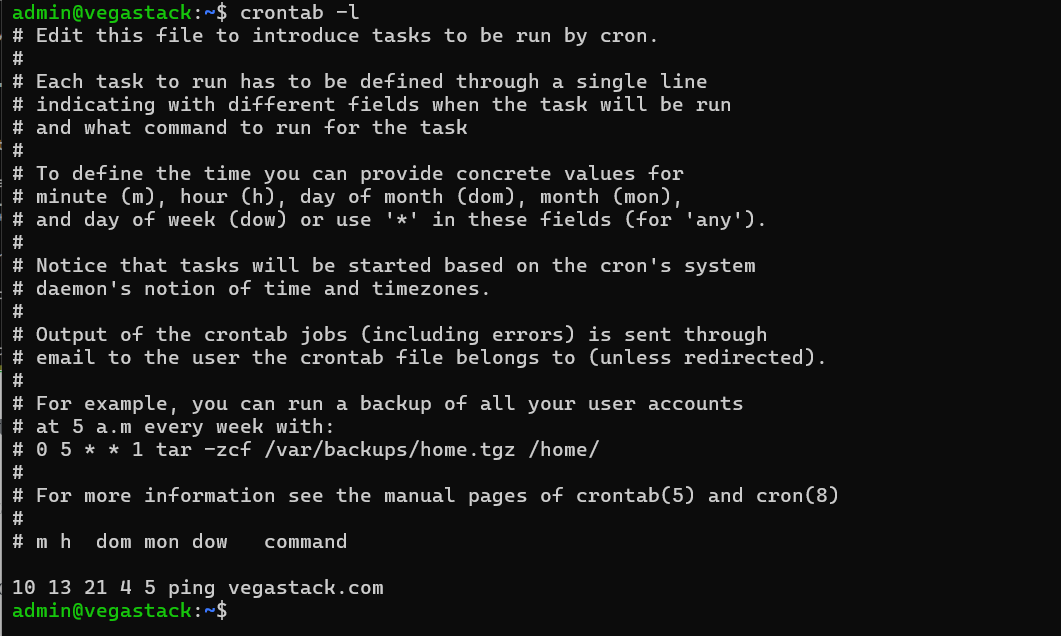
It prints out the entire crontab file of the specific user.
Crontab Syntax
The crontab syntax is better described using an example:
10 13 21 4 5 ping vegastack.comHere:
10: It’s the minute field. The value can be 0-59 or asterisk (*) which denotes every minute.13: It’s the hour field. The value can be 0-23 or asterisk (*) which denotes every hour.21: It denotes the day of the month. The value can be 0-31 or asterisk (*) which denotes every month.4: It denotes the month of the year. The value can be 1-12 or asterisk (*) which denotes every year.5: It denotes the day of the week. The value can be 0-6 or asterisk (*) which denotes every day of the week. Note that the week starts with Sunday.ping vegastack.com: At the specified time, cron runs the described command.
In short, cron pings the vegastack.com host on Friday, 21 March at 13:10.
Let’s put this knowledge in action. In the next example, we will monitor the disk space usage of /var/log every minute and write the result in a log:
* * * * * du -h /var/log > /tmp/disk-space.log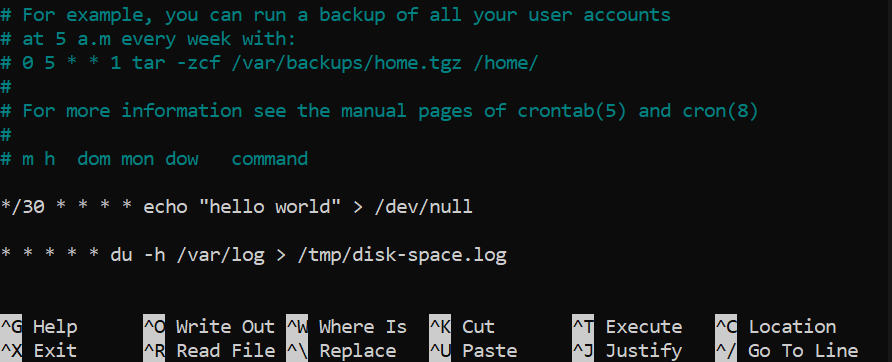
Cron also supports the ranged and stepped values. Check out the following examples:
0-30 */2 * * * <command_or_script>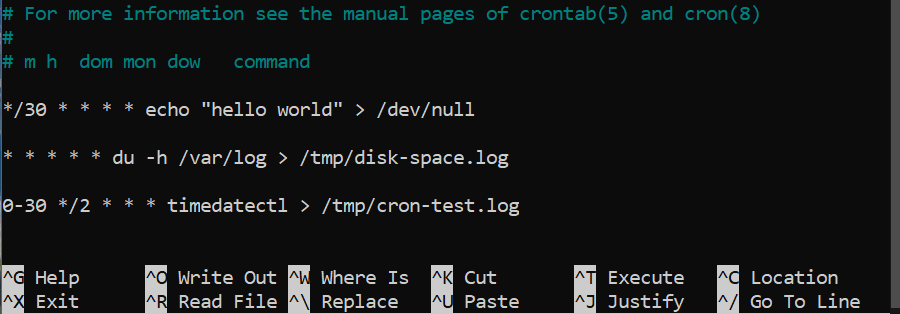
Here, the cron job runs each minute, for 30 minutes, every 2 hours.
There are also some special time syntaxes:
@reboot: The job is run after each system boot.@hourly: The job runs at the beginning of each hour.@daily: The job runs every day at 00:00.@weekly: The job runs each week on Sunday.@monthly: The job runs at the beginning of each month.@yearly: The job runs at the beginning of each year.
Having trouble with writing your own cron syntax or need help debugging? There are some interactive tools like crontab.guru that dramatically simplifies the process.
Crontab Example
This section features a handful of cron job examples.
Example 1: Auto Update the System
On Debian, to update all the installed packages, run the following commands:
sudo apt update
sudo apt upgrade -y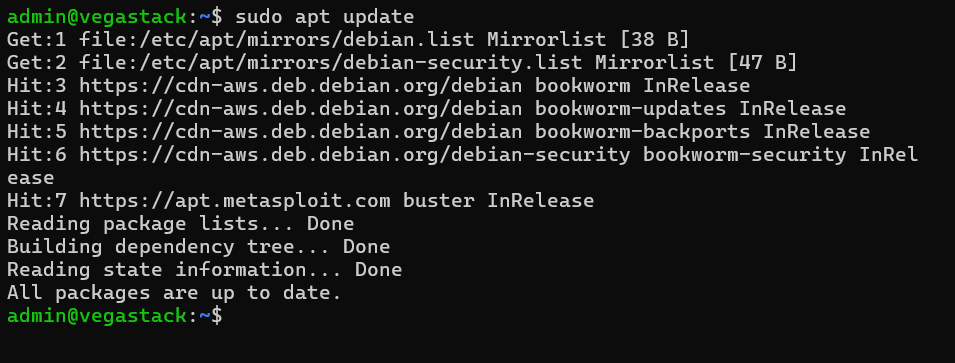
We can use crontab to automate this process. Making system changes require root permission, so we put the job under root.
Change the current user to root:
su -Now, launch the crontab editor:
crontab -eThe following cron job automatically checks for updates twice a day:
0 */12 * * * apt update && apt upgrade -y &> /dev/null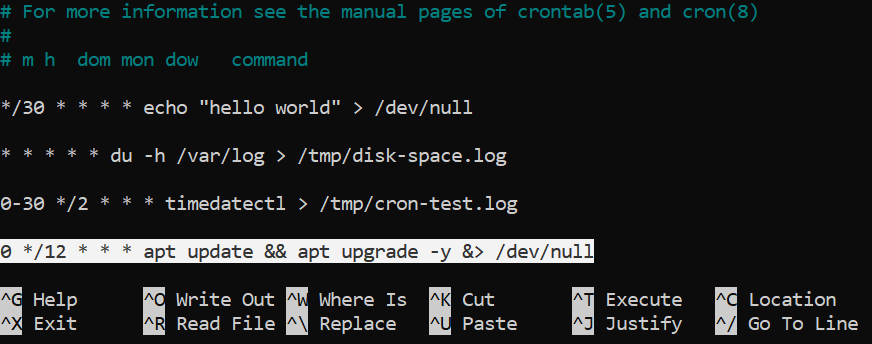
Example 2: Auto Shutdown
We can use cron to auto shutdown the system when certain conditions are met. For example, a certain host is unavailable due to power outage.
Take a look at the following Bash script:
while sleep 1 && ping -c 1 -w 3 "example.com" &> /dev/null
do
continue
done
/sbin/shutdown now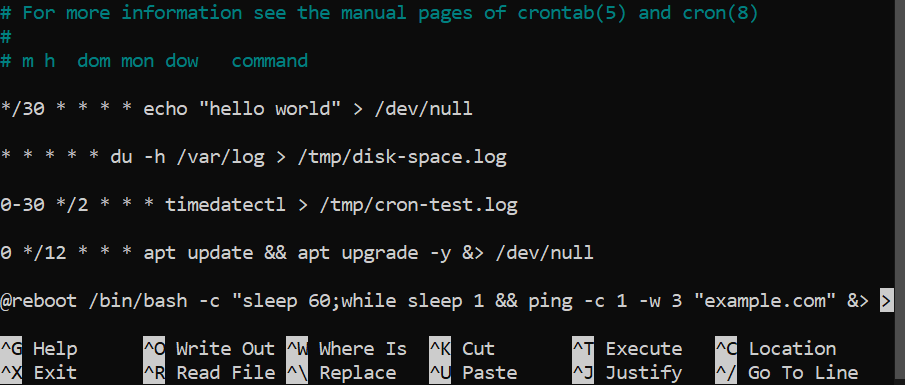
Here:
- We run an infinite
while - The
sleepcommand controls the rate of execution of the loop (every 1 second). - The
pingcommand pings the host com. - If the host is available, the loop continues. Since there’s nothing else to do, it starts the next iteration.
- If the host is unavailable, the loop ends and subsequently executes the
shutdown
We can transform the code into a single line:
while sleep 1 && ping -c 1 -w 3 "example.com" &> /dev/null; do continue; done; /sbin/shutdown nowWe can finally put the script into crontab:
@reboot /bin/bash -c "sleep 60;while sleep 1 && ping -c 1 -w 3 "example.com" &> /dev/null;do continue;done;/sbin/shutdown now"Here:
- We want the script to start running after the system boots.
- The additional
sleepcommand at the beginning ensures that the system boots up properly before executing the script. Change the value as needed. - Cron uses
/bin/shas the default shell. Since it’s a Bash script, we invoke the Bash shell to run the script.
Example 3: Automated Execution of Scripts
From the previous example, it’s clear that crontab entries can become extremely long, especially when it involves shell scripts. In addition, pruning scripts into a single line can be challenging, especially for big ones.
We can solve this issue by automating the launch of a shell script. With proper implementation, this technique can also dramatically reduce the number of required crontab entries.
To demonstrate, create a new shell script first:
touch test.sh
Mark the file as an executable:
chmod +x test.sh
You can place any shell script within the file. However, make sure to declare the proper shebang, as it dictates what interpreter actually runs the code. Learn more about shebang Bash.
Finally, automate the execution of the script in crontab:
crontab -e
*/5 * * * * <path_to_script>
FAQs on How to Setup Crontab on Debian 12
How do I open the crontab file for editing?
You can open the crontab file for editing by running the command crontab -e. This will open the default editor specified in your environment.
How do I schedule a new cron job?
To schedule a new cron job, you need to add a new line in the crontab file specifying the timing and command to be executed. Use the crontab -e command to edit the file.
How do I list all scheduled cron jobs?
You can list all scheduled cron jobs by running the command crontab -l. This will display the current crontab file's content.
Can I redirect the output of a cron job to a file?
Yes, you can redirect the output of a cron job to a file by appending > /path/to/outputfile.log to the command in the crontab entry.
How do I disable a cron job temporarily?
To disable a cron job temporarily, you can comment out the corresponding line in the crontab file by adding a # at the beginning of the line. Save the changes and they will take effect immediately.
How do I schedule a cron job to run every X minutes?
To schedule a cron job to run every X minutes, use the */X notation in the minute field of the cron expression. For example, */5 * * * * represents every 5 minutes.
Can I schedule a cron job to run at a specific time of the day?
Yes, you can schedule a cron job to run at a specific time of the day by specifying the desired hour and minute in the cron expression. For example, 0 8 * * * represents 8:00 AM.
Conclusion
We demonstrated how to setup Crontab on Debian 12. We discussed various types of crontab files and their impacts. Furthermore, we also learned about the crontab automation syntax. Finally, we demonstrated how to automate various tasks using crontab.
If you have any queries, feel free to ask them, and we would be happy to respond for sure....

